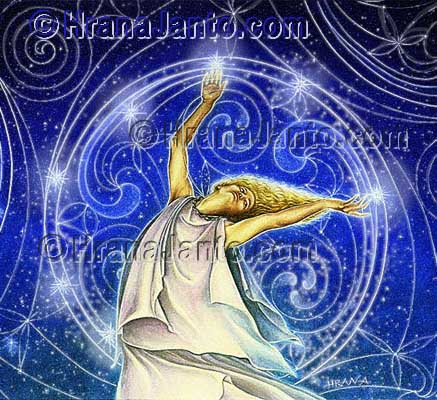 |
|
|||||
PREVIOUS | NEXT | A,B,C, D,E, F,G,H,I, J,K,L,M, N,O,P,Q, R,S, T,U,V,W,X,Y,Z | Help | ALL | INDEX
| Arianrhod from Goddesses and Heroines |
Exerpt from Goddess & Heroines by Patricia
Monaghan [Used by permission. This text is NOT included in the Goddess Oracle] |
The goddess of the "silver wheel" was a Welsh sorceress who, surrounded by women attendants, lived on the isolated coastal island of Caer Arianrhod. Beautiful and pale of complexion, Arianrhod was the most powerful of the mythic children of the mother goddess Don.
It was said that she lived a wanton life, mating with mermen on the beach near her castle and casting her magic inside its walls. She tried to pretend virginity, but a trial by the magician Math revealed that she had conceived two children whom she had not carried to term: in leaping over a wizard's staff, Arianrhod magically gave birth to the twins Dylan-son-of-Wave and the fetus of Llew Llaw Gyffes. Dylan slithered away and disappeared, but Arianrhod's brother, the poet Gwydion, recognized the fetus as his own child, born of his unexpressed love for his sister.
Gwydion took the fetus and hid it in a magical chest until it was ready to breathe. Arianrhod, furious at this invasion of her privacy, denied the child a name or the right to bear arms - two prerogatives of a Welsh mother-but Gwydion tricked Arianrhod into granting them. Eventually the goddess overreached herself, creating more magic than she could contain; her island split apart, and she and her maidservants drowned.
Some scholars read the legend as the record of a change from mother right to father rule, claiming that the heavenly Arianrhod was a matriarchal moon goddess whose particular place in heaven was in the constellation called Corona Borealis. The argument has much in its favor, particularly the archetypal relation of Arianrhod to her sister moon goddesses on the Continent, who like Artemis lived in orgiastic maidenhood surrounded entirely by women. Other scholars, unconvinced that the Celts were matriarchal at any time, see Arianrhod simply as an epic heroine.
| Back to TOP | Published by Llewellyn, copyright 1997. Used by permission of the author. |